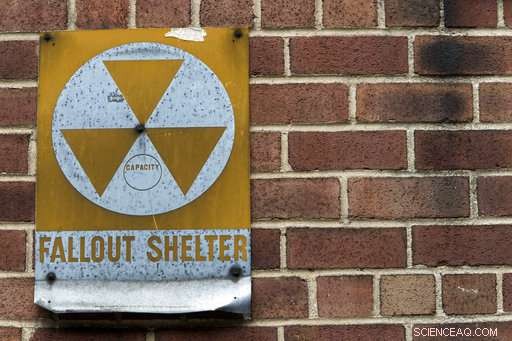
En este martes 16 de enero Foto de 2018, un letrero de un refugio contra la lluvia radiactiva cuelga de un edificio en East 9th Street en Nueva York. Los refugios de lluvia radiactiva marcados con letreros de metal con el símbolo de la radiación (tres triángulos unidos dentro de un círculo) se instalaron en decenas de miles de edificios en todo el país a principios de la década de 1960 en medio de la carrera de armamentos nucleares. Solo en la ciudad de Nueva York se creía que había alrededor de 18, 000. (Foto AP / Mary Altaffer)
Una generación de estadounidenses sabía exactamente qué hacer en caso de un ataque nuclear, o durante una falsa alarma importante, como el del fin de semana en Hawaii. Refúgiese en un edificio que tenga un símbolo de refugio de lluvia radiactiva amarillo.
Pero estos dias puede que no sea la mejor opción, o incluso una opción en absoluto.
Reliquias de la Guerra Fría, los viejos refugios que alguna vez se contaron por miles en las escuelas, los juzgados y las iglesias no se han mantenido. Y la sabiduría convencional ha cambiado sobre si un sistema de refugio de este tipo es necesario en una época en la que es más probable que un ataque provenga de un estado débil o de un grupo terrorista que de una superpotencia.
"No estamos en un escenario de Guerra Fría. Estamos en 2018, "dijo el Dr. Irwin Redlener, director del Centro Nacional de Preparación para Desastres del Instituto de la Tierra de la Universidad de Columbia. "No nos enfrentamos a lo que enfrentábamos hace 50 años, cuando la Unión Soviética y los Estados Unidos tenían ojivas nucleares apuntando entre sí que devastarían el mundo. Hay una amenaza pero hoy es un tipo diferente de amenaza ".
La gente no estaba segura de qué hacer el sábado cuando Hawai envió por error una alerta de teléfono celular advirtiendo de un misil balístico entrante y no lo retiró durante 38 minutos. El estado había establecido la infraestructura de alerta de misiles después de que Corea del Norte demostrara que sus misiles tenían el alcance para llegar a las islas. Los conductores abandonaron automóviles en una carretera y se refugiaron en un túnel. Los padres se acurrucaban en las bañeras con sus hijos. Los estudiantes atravesaron el campus de la Universidad de Hawái para refugiarse en los edificios.
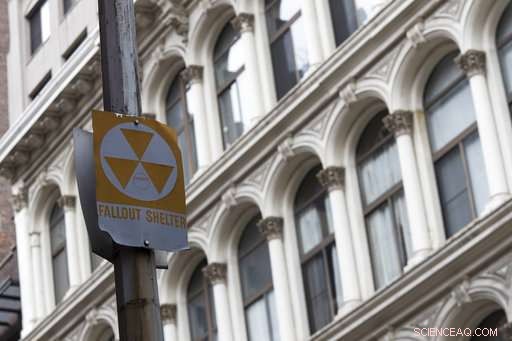
En este martes 16 de enero Foto de 2018, Los letreros de los refugios antiaéreos cuelgan de un poste de luz en East 11th Street en Nueva York. En un verdadero ataque nuclear ponerse a cubierto en un edificio con el símbolo amarillo oxidado de refugio antiaéreo puede que ya no sea la mejor opción. Los expertos dicen que los refugios en las escuelas y los juzgados son a menudo reliquias envejecidas de la Guerra Fría que no se han mantenido. (Foto AP / Mary Altaffer)
La falsa alarma es el momento perfecto para hablar sobre qué hacer en tal emergencia, Redlener dijo:porque la mayoría de las veces la gente no quiere hablar de eso. En absoluto.
"Pero es una posibilidad real, ", dijo." Los funcionarios de la ciudad deberían hablar sobre lo que deberían hacer sus ciudadanos si ocurriera un ataque. Y es una necesidad que las personas y las familias hablen y desarrollen su propio plan de lo que harían ".
Los neoyorquinos a los que se les preguntó esta semana dónde buscarían refugio durante un ataque con misiles dijeron que no tenían idea.
"Lo único que puedo pensar es, Yo correría, "dijo Sabrina Shephard, 45, de Manhattan. "Donde correríamos, No sé, porque no sé si Nueva York tiene refugios antiaéreos o algo así ".
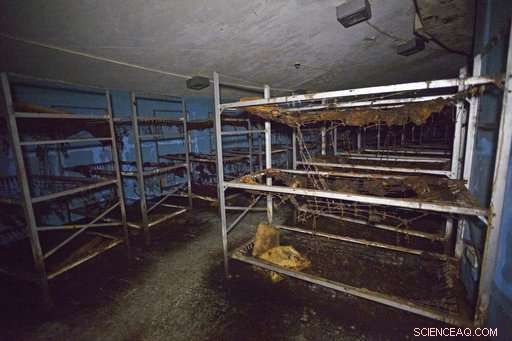
En este martes 26 de septiembre 2017 foto, se puede ver una bahía de literas en una habitación en forma de media luna dentro de un búnker de Defensa Civil de la era de la Guerra Fría en Nueva Orleans. Una generación de estadounidenses sabía exactamente qué hacer en caso de un ataque nuclear, o durante una falsa alarma importante, como el del fin de semana en Hawaii. Refúgiese en un edificio que tenga un símbolo de refugio de lluvia radiactiva amarillo. Pero estos dias puede que no sea la mejor opción, o incluso una opción en absoluto. (Max Becherer / The Advocate vía AP)
Los refugios de lluvia radiactiva marcados con letreros de metal con el símbolo de la radiación (tres triángulos unidos dentro de un círculo) se instalaron en decenas de miles de edificios en todo el país a principios de la década de 1960 en medio de la carrera de armamentos nucleares. In New York City alone there were believed to be about 18, 000.
The locations were chosen because they could best block radioactive material. Anything could be a shelter as long as it was built with concrete, cinder blocks or brick, had no windows, and could be retrofitted quickly with supplies, an air filtration system and potable water.
But the idea was controversial from the start, especially since one of the scenarios at the time, a full-scale nuclear war between the U.S. and the Soviet Union, would have left few survivors. By the 1970s, the concept was abandoned. A FEMA spokeswoman said the agency doesn't even have current information on where the shelters are located.
New York City education officials announced last month they are taking down the fallout shelter signs at schools. In Minot, Dakota del Norte, just a few miles from the base where dozens of U.S. missiles are at the ready, a few fallout shelter signs remain, but their status as viable refuges isn't known.
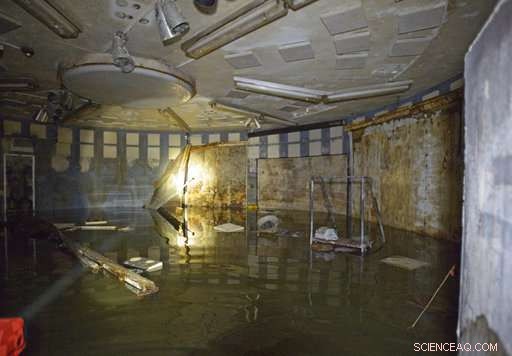
En este martes 26 de septiembre 2017 foto, a flashlight illuminates the main command center of a Cold War era Civil Defense bunker in New Orleans. The fallout shelters, marked with metal signs featuring the symbol for radiation - three joined triangles inside a circle - were set up in tens of thousands of buildings nationwide in the early 1960s amid the nuclear arms race. (Max Becherer /The Advocate via AP)
So what should you do if there is a nuclear attack now?
The good news:You may actually survive, because a nuclear attack today is more likely to be just one bomb—perhaps a small device, smuggled into a city inside a truck, or a single missile lobbed by North Korea that actually makes it across the water. The bad news:You have between 15 and 20 minutes to get to a safe space.
Eliot Calhoun, a disaster planner for New York's Emergency Management Department, said the smartest thing to do is stay put in a spot with as few windows and as many walls as possible.
"Don't go outside unless you absolutely must, " él dijo.
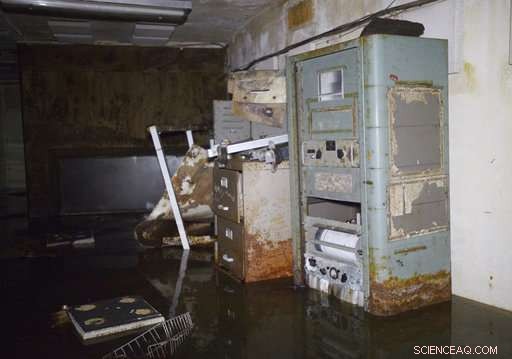
En este martes 26 de septiembre 2017 foto, old office equipment stands in a room near the entryway of a Cold War era Civil Defense bunker located in the neutral ground of West End Boulevard near Robert E. Lee Boulevard in New Orleans, La. Relics from the Cold War, the aging shelters that once numbered in the thousands in schools, courthouses and churches haven't been maintained. And conventional wisdom has changed about whether such a shelter system is necessary in an age when an attack is more likely to come from a weak rogue state or terrorist group rather than a superpower. (Max Becherer /The Advocate via AP)
Subterranean subway stations might be a good place to shelter if you happen to be in one when an attack happens, but experts say tunnels could also be dangerous if they are structurally compromised by a blast.
New Yorker Joe Carpenter emerged from a post office with a faded fallout shelter sign this week and admitted that he had never thought about what to do in the event of an incoming missile.
"I probably would just huddle with the masses and go along with the crowd, because I've never really considered it, " he said. "It's like everything else:Do we really ponder what's at the end of the road?"
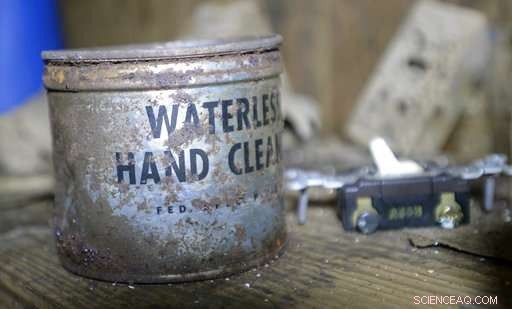
En este martes 26 de septiembre 2017 foto, a container of waterless hand cleaner sits in a storage room inside an abandoned Cold War era Civil Defense bunker in New Orleans. Relics from the Cold War, the aging shelters that once numbered in the thousands in schools, courthouses and churches haven't been maintained. And conventional wisdom has changed about whether such a shelter system is necessary in an age when an attack is more likely to come from a weak rogue state or terrorist group rather than a superpower. (Max Becherer /The Advocate via AP)
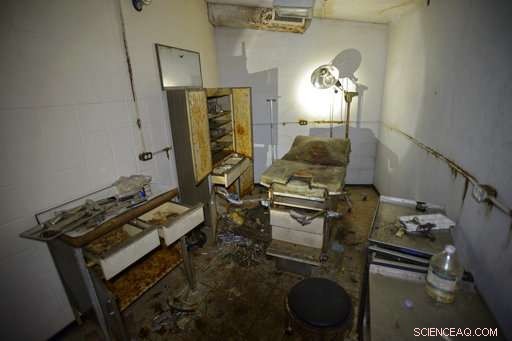
En este martes 26 de septiembre 2017 foto, an infirmary complete with a medical bed and medical instruments is seen inside a Cold War era Civil Defense bunker in New Orleans. Relics from the Cold War, the aging shelters that once numbered in the thousands in schools, courthouses and churches haven't been maintained. And conventional wisdom has changed about whether such a shelter system is necessary in an age when an attack is more likely to come from a weak rogue state or terrorist group rather than a superpower. (Max Becherer /The Advocate via AP)
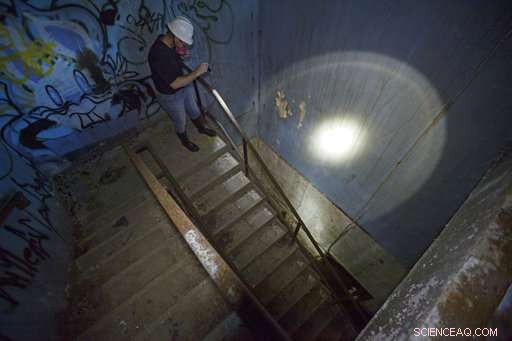
En este martes 26 de septiembre 2017 foto, Derek Boese, the Chief Administrative and Public Information Officer for the Southeast Louisiana Flood Protection Authority-East, uses a flashlight to illuminate the stair well of a Cold War era Civil Defense bunker in New Orleans. In a real nuclear disaster, taking cover in a building bearing a rusted yellow fallout shelter symbol may not be the best option anymore. Experts say the shelters in schools and courthouses are often aging relics from the Cold War that haven't been maintained. And conventional wisdom has changed. (Max Becherer /The Advocate via AP)
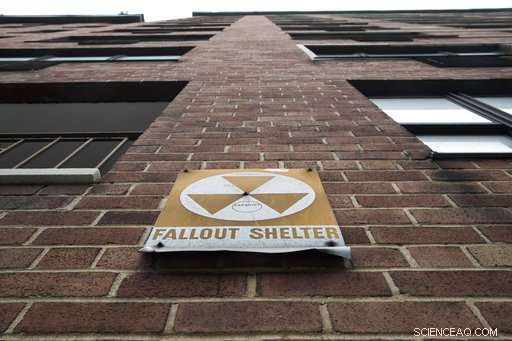
En este martes 16 de enero 2018 photo, a fallout shelter sign hangs on a building on East 9th Street in New York. A generation of Americans knew just what to do in the event of a nuclear attack—or during a major false alarm, like the one over the weekend in Hawaii. Take cover in a building bearing the yellow fallout shelter symbol. But these days, that might not be the best option, or even an option at all. (Foto AP / Mary Altaffer)
© 2018 The Associated Press. Reservados todos los derechos.